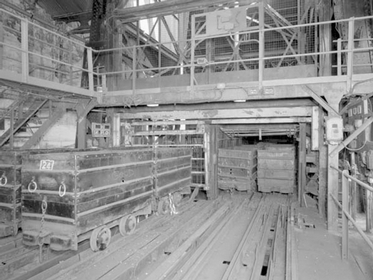The Story of Scottish Coal
View of the pithead at Lady Victoria Colliery near Edinburgh, which has been preserved as part of the Scottish Mining Museum.
© Crown copyright: RCAHMS, SC758226, 1998
© Crown copyright: RCAHMS, SC758226, 1998
At the heart of Lady Victoria Colliery is the shaft, up which coal was hauled by a large steam winding engine made in Kilmarnock, Ayrshire in 1894. The coal was carried in wagons inside two cages, and was then released onto a circuit, after which it was weighed and then emptied and taken for sorting and preparation in other parts of the colliery. The empty wagons were then put back into the cages and taken back to the bottom of the shaft.
After several catastrophic mining disasters in which miners were trapped underground because of the collapse of a colliery's only shaft, it became the law that every mine must have more than one means of access. Lady Victoria Colliery was therefore unusual because it only ever had one shaft. However, it was connected to another mine, Lingerwood Colliery, which not only provided a vital means of escape, but also was an important part of the underground ventilation system.
This view shows the top of the shaft, and the cage with its door open and two wagons waiting to be pushed onto the circuit for weighing and emptying. More modern collieries had skips instead of wagons.
After several catastrophic mining disasters in which miners were trapped underground because of the collapse of a colliery's only shaft, it became the law that every mine must have more than one means of access. Lady Victoria Colliery was therefore unusual because it only ever had one shaft. However, it was connected to another mine, Lingerwood Colliery, which not only provided a vital means of escape, but also was an important part of the underground ventilation system.
This view shows the top of the shaft, and the cage with its door open and two wagons waiting to be pushed onto the circuit for weighing and emptying. More modern collieries had skips instead of wagons.


